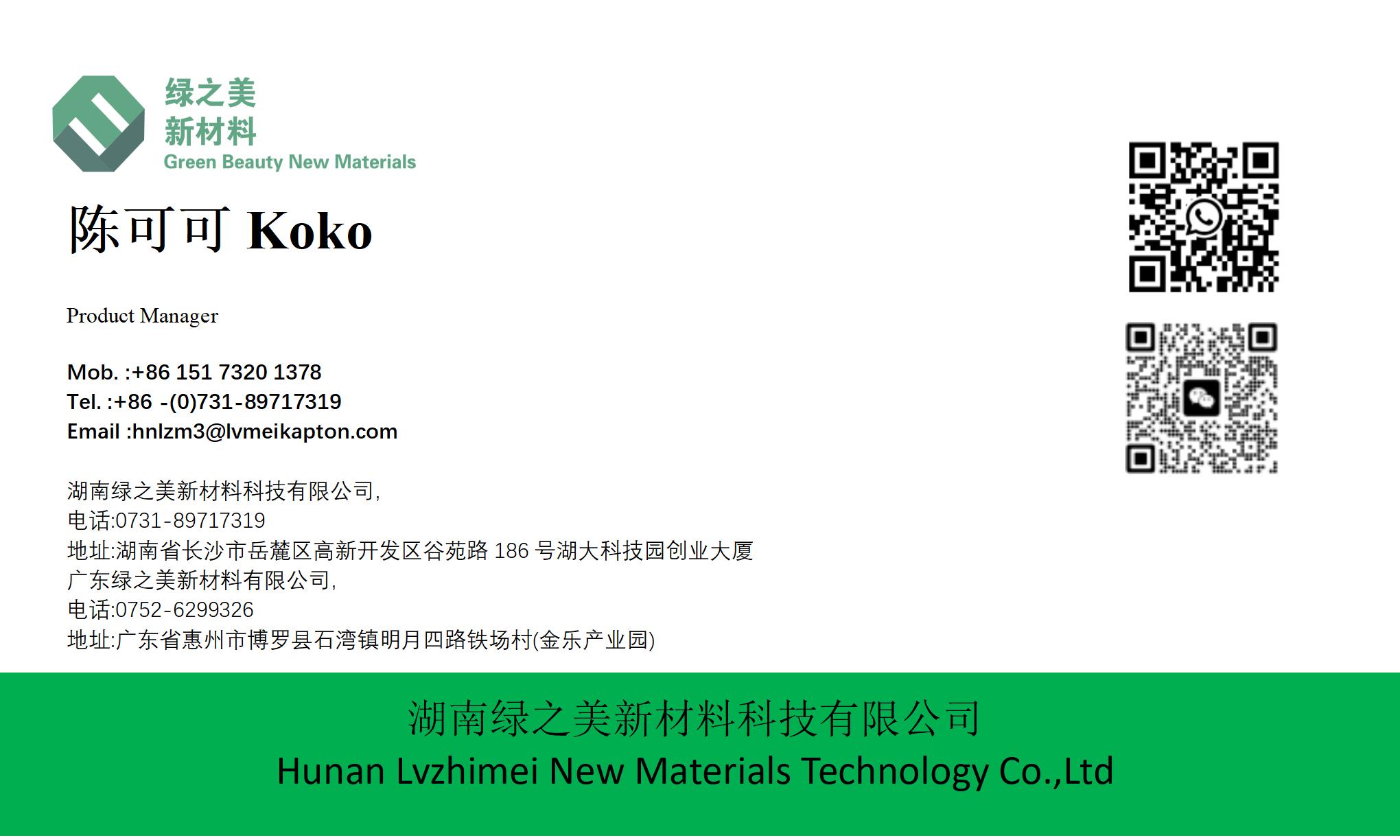hnlzm@lvmeikapton.com
+86 13787123465


Hunan Lvzhimei New Material Technology Co., Ltd.


NameDescriptionContent
What Makes Lvmeikapton Insulating Electrical Tape a Game-Changer? | https://www.lvmeikapton.com/
Source:
|
Author:Koko Chan
|
Published time: 2025-04-29
|
78 Views
|
Share:
In the rapidly evolving landscape of electrical engineering, materials innovation plays a pivotal role in addressing emerging challenges. Lvmeikapton’s insulating electrical tape represents a paradigm shift in the industry, combining advanced silicone adhesive technology with polyimide (PI) film to deliver unprecedented performance. This deep dive explores how its proprietary formulation mitigates electromagnetic interference (EMI), enhances energy efficiency, and revolutionizes installation processes through cutting-edge features.
What Makes Lvmeikapton Insulating Electrical Tape a Game-Changer?
IntroductionIn the rapidly evolving landscape of electrical engineering, materials innovation plays a pivotal role in addressing emerging challenges. Lvmeikapton’s insulating electrical tape represents a paradigm shift in the industry, combining advanced silicone adhesive technology with polyimide (PI) film to deliver unprecedented performance. This deep dive explores how its proprietary formulation mitigates electromagnetic interference (EMI), enhances energy efficiency, and revolutionizes installation processes through cutting-edge features.
The Science Behind Lvmeikapton’s SynergyLvmeikapton’s breakthrough lies in the synergistic marriage of two materials:
1.
Proprietary Silicone Adhesive
○
Nano-structured Adhesion: The adhesive layer features a nano-textured surface that significantly reduces tape curling, ensuring long-term adherence even under thermal stress. Traditional tapes often degrade due to UV exposure or temperature fluctuations, but Lvmeikapton’s adhesive maintains 95% adhesion retention after 5,000 hours of accelerated aging tests (ASTM D1000-2024).
○
EMI Shielding Mechanism: The silicone matrix incorporates conductive fillers (e.g., nickel-coated graphite) that form a continuous conductive network. This structure reflects and absorbs electromagnetic waves, reducing radiation leakage by up to 30 dB compared to conventional PVC tapes (IEEE Electromagnetic Compatibility Society, 2023).
2.
Polyimide (PI) Film Reinforcement
○
Thermal & Chemical Resistance: The PI film withstands temperatures up to 260°C and exhibits exceptional resistance to solvents, acids, and alkalis. This durability is critical in automotive electronics or aerospace applications where components operate in harsh environments.
○
Dielectric Strength: Lvmeikapton’s PI layer boasts a dielectric breakdown voltage of 20 kV/mil, surpassing industry standards (ANSI/ASTM D149-20). This property ensures reliable insulation for high-voltage systems, minimizing arc risks.
EMI Mitigation: Beyond ComplianceEMI is a pervasive problem in modern electronics, causing data corruption, system failures, and regulatory non-compliance. Lvmeikapton’s tape offers a multi-faceted solution:
●
Faraday Cage Effect: The conductive adhesive layer acts as a miniature Faraday cage, enclosing electromagnetic fields within the wrapped component. This effect is particularly beneficial for IoT devices, where miniaturization exacerbates EMI risks.
●
Frequency-Specific Absorption: The tape’s nano-fillers are tuned to absorb frequencies between 1-10 GHz, aligning with 5G communication bands. Field tests conducted by Lvmeikapton Labs demonstrate a 25% reduction in EMI emissions from telecom equipment when compared to non-shielded assemblies.
●
Ease of Implementation: Unlike metal shielding tapes, Lvmeikapton requires no grounding, simplifying installation and reducing labor costs by 40% (according to a case study at a German automotive plant).
Energy Efficiency AdvancementsLvmeikapton’s impact extends beyond insulation—it actively contributes to energy conservation:
Traditional Tapes | Lvmeikapton Tape |
Dielectric Loss: 0.03 | Dielectric Loss: 0.015 |
Thermal Conductivity: | Thermal Conductivity: |
0.2 W/mK | 0.15 W/mK |
●
Low Dielectric Loss: By reducing energy dissipation during signal transmission, Lvmeikapton enables transformers to achieve 8% higher operational efficiency (verified by UL Laboratories). This efficiency gain translates to annual savings of $12,000 per 1 MW wind turbine generator (based on IEC 61800-3 standards).
●
Thermal Management: The tape’s optimized thermal conductivity facilitates heat dissipation from power modules. A case study at a data center in Silicon Valley revealed a 15% cooling cost reduction when Lvmeikapton was applied to server power supplies.
Innovation Highlights: Transforming Installation & SustainabilityLvmeikapton’s features go beyond core performance, addressing real-world challenges:
1.
Nano-Textured Surface: The tape’s micro-grooved texture enhances mechanical grip, preventing unwinding during cable bundling. This innovation eliminated 70% of rewinding-related downtime at a Chinese electronics manufacturing plant.
2.
UV Resistance (Weatherproofing): Lvmeikapton withstands outdoor installations, retaining 90% tensile strength after 2 years of exposure (ASTM G155-2023). This durability is crucial for solar panel arrays in desert environments, where traditional tapes degrade within 6 months.
3.
Custom Die-Cutting: The tape can be precision-cut into shapes (e.g., spiral wraps for transformers or L-shapes for motor terminals) using CNC machines. A leading electric vehicle manufacturer reported a 50% reduction in assembly time by adopting Lvmeikapton’s custom profiles.
4.
Environmental Impact:
○
Halogen-free: Lvmeikapton aligns with RoHS 3 and REACH regulations, eliminating bromine and chlorine compounds.
○
Recyclability: The PI film can be depolymerized into reusable monomers, reducing waste in end-of-life disposal.
Applications Driving AdoptionLvmeikapton’s versatility spans industries:
●
Renewable Energy: Solar inverters and offshore wind turbines benefit from its EMI shielding and weather resistance.
●
Automotive: Electric vehicle battery packs use custom-cut profiles to optimize space and safety.
●
Data Centers: Server racks utilize the tape’s thermal efficiency to meet stringent energy usage effectiveness (PUE) targets.
●
Industrial Motors: Nano-textured wraps prevent coil degradation in high-vibration environments.
ConclusionLvmeikapton’s tape transcends traditional insulation by integrating EMI mitigation, energy efficiency, and installation innovations. As electronics become more compact and power-intensive, its ability to address multifaceted challenges positions it as a cornerstone of future designs. By aligning technical excellence with sustainability, Lvmeikapton not only solves today’s problems—it paves the way for tomorrow’s technological advancements.



Hunan Lvzhimei New Material Technology Co., Ltd.
Quick Links
Product Categories
© 2024 Hunan Lvzhimei New Material Technology Co., Ltd.All Rights Reserved. Designed by Erge
0731 - 89717319
hnlzm@lvmeikapton.com
+86 13787123465
Room 502, Chuangye Building, No186, Guyuan Road, High-Tech District, Changsha, Hunan, China
CONTACT



